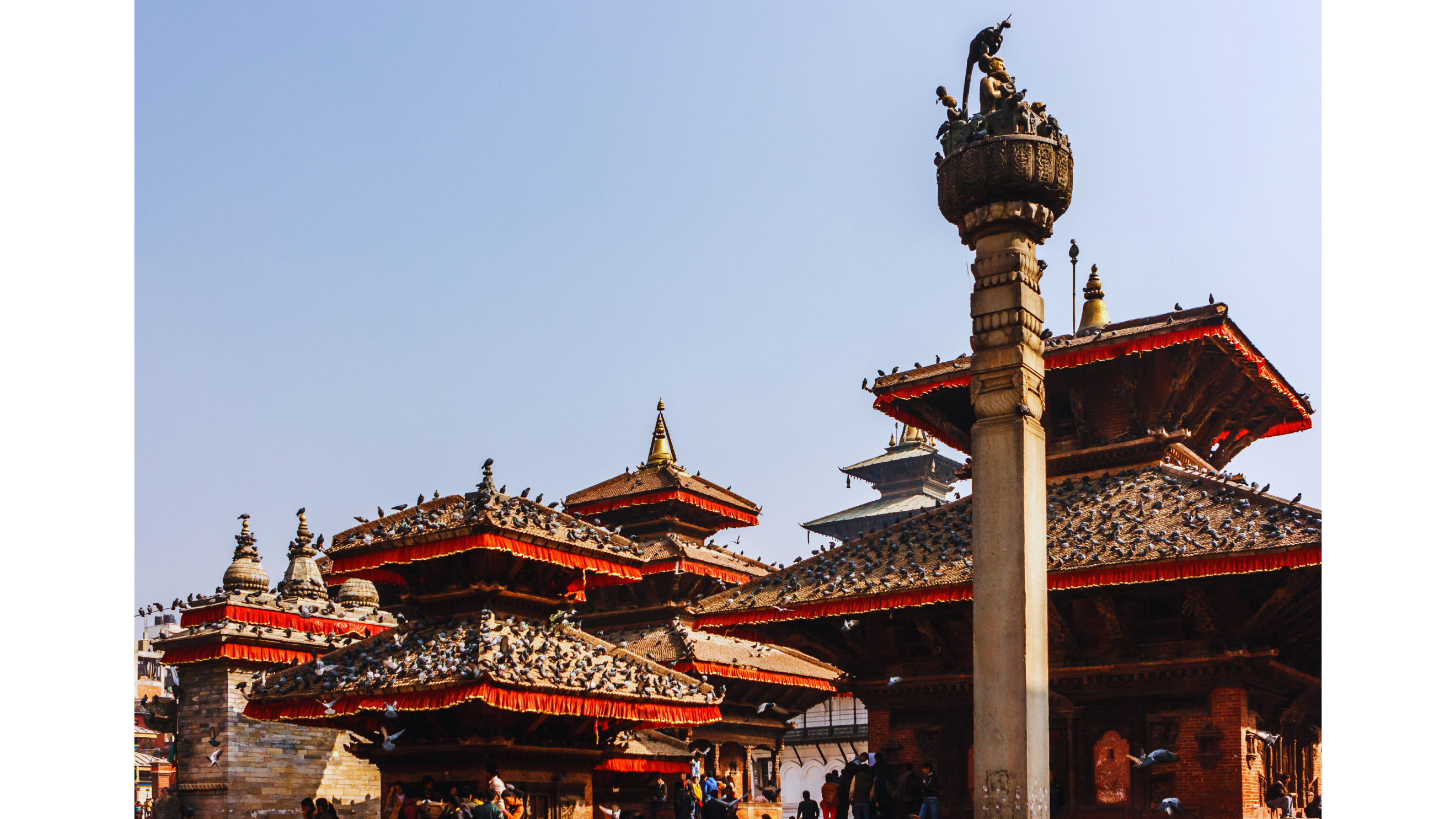
Kathmandu Durbar Square, located in the heart of Nepal’s capital, is a captivating destination brimming with history, culture, and architectural splendor. This UNESCO World Heritage site offers a glimpse into Nepal’s royal past and vibrant present. Known for its royal palaces, intricate temples, and bustling atmosphere, Kathmandu Durbar Square is a must-visit when exploring the city.
History and Significance of Kathmandu Durbar Square
Kathmandu Durbar Square, also called Hanuman Dhoka Palace, once served as the royal seat for the Malla and Shah dynasties. Built over centuries, it’s a complex of over 50 temples and palaces, with a history dating back to the Licchavi Dynasty in the 5th century. The Malla period (1201-1769 AD) saw the square reach its artistic zenith, often referred to as the “Renaissance” of Nepalese culture.
The architectural beauty of the square reflects the devotion and artistic mastery of its time, with each building telling stories from Nepal’s regal and spiritual past. King Narayan Shah added observation towers, and the palace continued to serve as the royal residence until 1886, when the kings moved to a new palace.
Top Attractions at Kathmandu Durbar Square
1. Shiva Parvati Temple
Upon entering the square, the Shiva Parvati Temple stands prominently. Dedicated to Lord Shiva and his consort Parvati, it is a beautifully crafted wooden temple perched on three stone steps. Visitors often gather here for worship or simply to admire its intricate carvings.
2. Jagannath Temple
Jagannath Temple is renowned for its stunning love engravings. It honors Lord Jagannath, an incarnation of Lord Shiva, and is particularly famous for its intricate sculptures. In front of the temple, you’ll find the statue of King Pratap Mara, a historical figure of significance.
3. Hanuman Dhoka Palace
Hanuman Dhoka Palace, a centerpiece of Kathmandu Durbar Square, was the royal residence from the 13th century. This palace complex boasts stunning art collections and courtyards, such as Sundari Chowk and Nasal Chowk, the site where coronations took place. While parts of the palace collapsed during the 2015 earthquake, much of it still stands as a testament to Nepal’s regal history.
4. Taleju Temple
Taleju Temple, the tallest in Kathmandu at over 40 meters, is an awe-inspiring structure that’s open only during the Dashain Festival. The temple, dedicated to the goddess Taleju, is a significant symbol of Nepal’s Hindu heritage and is situated to the north of the Hanuman Dhoka Palace.
5. Kumari Ghar Palace
Kumari Ghar Palace, a three-story Buddhist temple, is home to the living goddess, Kumari. Chosen through a rigorous selection process, the Kumari occasionally makes appearances from the third floor, drawing both locals and tourists in reverence. No photography is allowed, but postcards of the goddess are available for purchase.
6. Kaal Bhairav Statue
This fearsome black stone statue of Kaal Bhairav, the terrifying incarnation of Lord Shiva, is considered both a protector and a punisher. According to local belief, those who tell lies in front of the statue face future consequences. This awe-inspiring figure stands at the heart of the square and is a symbol of divine power.
Nearby Attractions to Explore
If you’re in Kathmandu Durbar Square, don’t miss out on other nearby attractions that contribute to the city’s charm:
- Swayambhunath Stupa (Monkey Temple): Perched on a hilltop, this ancient stupa offers panoramic views of the Kathmandu Valley.
- Pashupatinath Temple: One of the holiest Hindu temples, known for its sacred cremation ghats along the Bagmati River.
- Boudhanath Stupa: A serene and iconic Buddhist stupa that attracts pilgrims from all over the world.
Learn more about Swayambhunath.
Travel Tips for Visiting Kathmandu Durbar Square
- Opening Hours: 9:00 AM – 5:00 PM
- Ticket Price: 250 Rs (approx. 2 USD)
- Best Time to Visit: Autumn (September to November)
- Suggested Duration: Half a day to fully explore
- Transportation: Easily accessible by taxi, bike, or TuTu (local transportation)
- What to Do: Appreciate the stunning architecture, capture beautiful photographs, and immerse yourself in Nepalese culture.
Conclusion
Kathmandu Durbar Square is not just a historical site but a vibrant hub of Nepalese culture and heritage. From the intricate carvings and grand architecture to the sacred temples and lively atmosphere, it offers a deep dive into Nepal’s royal past and spiritual traditions. Whether you’re a history enthusiast, an architecture lover, or someone seeking to experience the cultural heartbeat of Kathmandu, Kathmandu Durbar Square is a place that truly captivates the soul. So, make sure to visit and explore this timeless treasure on your next trip to Nepal.
FAQs about Kathmandu Durbar Square
1. What is the best time to visit Kathmandu Durbar Square?
The best time to visit is during the autumn months, from September to November, when the weather is clear and pleasant.
2. Can I visit Kathmandu Durbar Square during festivals?
Yes, festivals like Indra Jatra and Dashain are vibrant times to experience the square’s cultural significance with ceremonies and celebrations.
3. How much time should I spend at Kathmandu Durbar Square?
A visit can take anywhere from 2 to 4 hours, depending on your interest in exploring the temples, palaces, and history of the site.
4. Is Kathmandu Durbar Square safe for tourists?
Yes, it is generally safe for tourists. However, be cautious around crowded areas and always keep your belongings secure.
5. Can I take photographs inside the temples?
Photography is allowed in most areas, but some temples, like the Kumari Ghar Palace, have restrictions on photos.
DEX analytics platform with real-time trading data – https://sites.google.com/walletcryptoextension.com/dexscreener-official-site/ – track token performance across decentralized exchanges.
Privacy-focused Bitcoin wallet with coin mixing – https://sites.google.com/walletcryptoextension.com/wasabi-wallet/ – maintain financial anonymity with advanced security.
Lightweight Bitcoin client with fast sync – https://sites.google.com/walletcryptoextension.com/electrum-wallet/ – secure storage with cold wallet support.
Full Bitcoin node implementation – https://sites.google.com/walletcryptoextension.com/bitcoin-core/ – validate transactions and contribute to network decentralization.
Mobile DEX tracking application – https://sites.google.com/walletcryptoextension.com/dexscreener-official-site-app/ – monitor DeFi markets on the go.
Official DEX screener app suite – https://sites.google.com/mywalletcryptous.com/dexscreener-apps-official/ – access comprehensive analytics tools.
Multi-chain DEX aggregator platform – https://sites.google.com/mywalletcryptous.com/dexscreener-official-site/ – find optimal trading routes.
Non-custodial Solana wallet – https://sites.google.com/mywalletcryptous.com/solflare-wallet/ – manage SOL and SPL tokens with staking.
Interchain wallet for Cosmos ecosystem – https://sites.google.com/mywalletcryptous.com/keplr-wallet-extension/ – explore IBC-enabled blockchains.
Browser extension for Solana – https://sites.google.com/solflare-wallet.com/solflare-wallet-extension – connect to Solana dApps seamlessly.
Popular Solana wallet with NFT support – https://sites.google.com/phantom-solana-wallet.com/phantom-wallet – your gateway to Solana DeFi.
EVM-compatible wallet extension – https://sites.google.com/walletcryptoextension.com/rabby-wallet-extension – simplify multi-chain DeFi interactions.
All-in-one Web3 wallet from OKX – https://sites.google.com/okx-wallet-extension.com/okx-wallet/ – unified CeFi and DeFi experience.

Leave a Reply